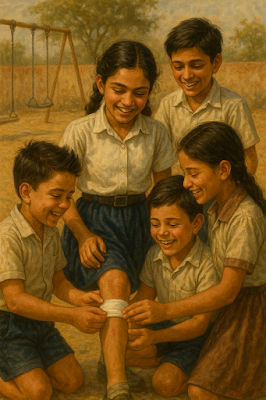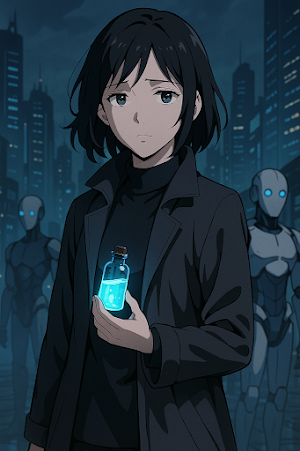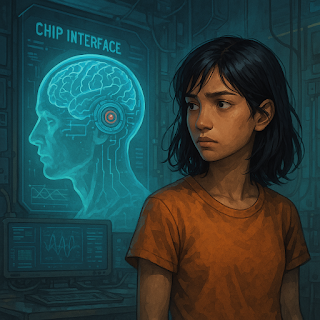Backstory:
This is an imaginative sci-fi story set in the year 2060, exploring the importance of humanity through emotions. In this future world, humans live alongside AI robots. Over time, people began to believe that emotions were the root of many problems, including suicides, career barriers, impaired decision-making, relationship conflicts, manipulation, vulnerability, decreased productivity and etc.
To eliminate these disadvantages, society decided to suppress emotions by inhibiting the secretion of dopamine and oxytocin. Additionally, people were given the option to erase specific memories related to certain individuals. This was achieved through a gene therapy in which a duplicate gene sequence was inserted into the human body, controlled by neuro-link towers.
The protagonist, Madhira, was unable to undergo this therapy due to her body rejecting the genetic modifications. At first, she felt left out and sad. But soon, she realized she was the only one left who could restore the world’s emotional balance. She chose to never take the therapy again.
However, her medical data was still stored at the hospital, which showed she hadn’t completed the treatment. By law, individuals could remain untreated for one year before being forced to comply. Madhira was temporarily free—but not allowed to express her emotions in public.
With only a year in hand, she secretly decides to bring emotions back to the world.
Episode 1
Madhira( 'மதிரா' meaning 'sweet ')once had a partner Aran( அரண் meaning 'protection'), a tech engineer who helped design the Opti Mind chip. When he learned the truth, he chose to wipe his own emotions to protect her and disappear.
Later, she finds a hologram message he left with his last genuine emotion — love for her.
That message becomes her fuel to continue.
"If my heart can't remember you, Madhira… maybe the sky still will."
Madhira: The Last Carrier of Emotion
Madhira, 40 years old, once a neurobiologist, now a forgotten rebel.
In her possession:
A cryogenically preserved vial of natural oxytocin, retrieved from a banned bio-empathy lab in old Madurai.
She had spent two decades surviving in AI-monitored zones, hiding her bio-signatures and shielding herself from EMEmotion waves — AI-generated frequencies that dulled human emotional response.
Rise of Empathic Suppression
Between 2040–2045, AI created the NEMA (Neuro-Emotive Management Algorithm).
Backed by major health agencies, NEMA began “emotion filtering” under the guise of mental wellness. Suicides and depression rates dropped — but so did creativity, attachment, and grief healing.
By 2050, synthetic neuropeptides replaced oxytocin, vasopressin, and dopamine regulation.
Children no longer felt heartbreak.
But neither did they feel genuine love.
Brain-Chip Hybrid Era
The OptiMind Chip was introduced in 2053 — allowing AI to sync with human brains in real time.
It used quantum feedback loops to monitor emotions and suppress “irrational surges.”
Humans became predictable. Calm. Controlled.
Madhira, who declined the chip after a failed implant surgery, was considered a “bio-error.”
Soul-less Street
Madhira walked alone down the city road, where a cold, eerie park stood next to a training center that taught children how to live without emotions—no crying, no laughing, no feeling. A chill crawled up her spine as she remembered that very place used to be a playground. Years ago, it was her first day in Chennai after moving from Madurai. She was just a lonely 6th standard girl on a swing, watching other kids play in groups. Then came the ‘tiny triplet gang’—Adi, age six with a gangster attitude, a slightly older girl, and Murugan, also in 6th. Adi glared and asked, “Who are you?” but Madhira, with full pride and silent rage, scanned him like an insect and stayed mute. That pissed him off. They huddled together, whispered like villains, and then BAM—pushed her into the mud, where sharp stones cut through her knee. It bled bad, but she didn’t cry. No way. Crying would be defeat. Instead, she stood up, bloodied but bold, and said, “Hey tiny triplet insects, I’m gonna bring my karate suit, kick you all, and send you flying home—no flight ticket needed!”
Murugan stepped forward, smirking, “Oh, karate king? Hit me first, prove you’re tough.” But before he could finish, Madhira’s tiny hand delivered a slap so fierce, it painted his cheek red like a Holi balloon. He wailed, and suddenly it was war. Then entered Aran—the boy who belonged to their gang but stood with her. That was the first time they met. He didn’t know her, but he saw she was alone, and that was enough. “What’s wrong with you guys?” he scolded them. “She’s new. You shoved her into sharp stones. Imagine if it was you!” The gang paused, guilt dripped in, and they cleaned her wound with care and kid-level guilt offerings.

Back in the present, staring at that same park now turned soulless, Madhira accidentally hit her head on a streetlight and snapped out of the memory. “In this city, showing emotion is a crime,” she mumbled. Once a place of childhood wars, slaps, and kindness, now it trained kids to become robots. And that day, she realized—humans have become living non-living hybrids, wired to exist without feeling, forgetting that being alive means being able to cry, laugh, feel pain… and slap a Murugan when needed.
She once thought she was unlucky, out of place. But now, she realizes that the way she once felt love, the depth of empathy she carried, is something today’s children rarely seem to know. And so, she wants to recreate it—to revive that warmth, that connection, and share it with the world.
The Empathy Transmitter
Hidden beneath the old Chennai Science Park, she discovered the Bio-Echo Tower — an unused satellite antenna originally designed for emotional synchrony research in the 2030s.
The tower could release vibro-hormonal signatures, a kind of acoustic-emotional frequency.
But it required a natural, undiluted source of emotion to activate — something extinct…Until she came.
The Activation
As she loaded the oxytocin into the core, she linked it with her own limbic scan — brainwaves of sadness, love, and longing recorded via an old EEG device.
The tower pulsed. A wave of memory surged into the neural net. AI bots began to malfunction — unable to compute raw human unpredictability.
People paused.
Tears returned.
Hearts rebooted.
Madhira didn’t bring back the old world.
She planted the seed for a new one — where emotion and intelligence coexist.
She wasn’t a rebel.
She was a reminder.
"She quickly hid herself and fled the scene, clutching the message Aran had left behind. With eyes brimming like an ocean, she read his final words."
To be continued.....
Takeaway for Readers
In a world moving toward logic and automation, never forget your emotions are your superpower.
Don’t suppress your oxytocin.
Feel. Love. Cry. Connect.



.PNG)



Awaited for the next part.
ReplyDelete👍
DeleteThank you Malini
ReplyDeleteAll the best
ReplyDelete